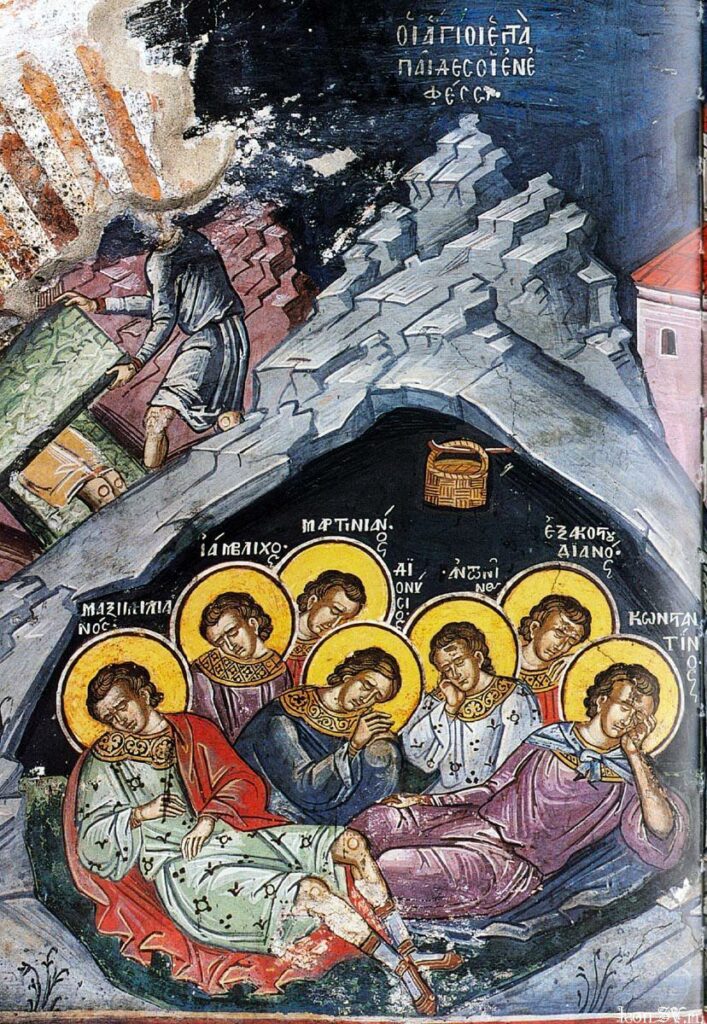Commemorated on October 22

These seven youths, Maximilian, Iamblicus, Martinian, John, Dionysius, Constantine and Antoninus, lived during a time where Christians were still under rigid persecution. In the early 3rd century, these boys were all raised in Ephesus, from esteemed families and Maximilian was son to a high ranking city official.
They were friends from their early age and remained close as they attending the military together. A new emperor came to rule in 249 AD, Decius. He was hateful toward Christians and commanded all in Ephesus to bow down and bring sacrifices to the pagan gods. He threatened those who disobeyed with severe torments and death. The youths were Christians and had no intention of sacrificing anything to the idols. Others who noticed they did not follow the emperors orders turned them in and Decius called them before his council. All seven of the young boys professed their love of Christ and they were then stripped of their soldier badges and belts.
Decius did not further punish them, as he was hopeful they would be swayed into worshipping the idols. The boys knew that their time was numbered, so they went off into the caves of Mount Ochlon where they prepared themselves with prayer and fasting.
The youngest of the boys, Iamblicus, went into town dressed as a peasant and bought bread. He did this several times and one day he heard that Decius was looking for them as he had returned from his military campaign. and he had already discovered their hiding spot.
The youths did not want the soldiers to capture them and feared they may be swayed to worship the idols. So they prayed to God to take their souls before the soldiers arrived. Our Lord, having mercy on them, put them under a deep and miraculous sleep that preserved their bodies and kept them from dying.

When the soldiers found the caves and the youth “dead” the emperor ordered that the cave was sealed as he did not care to properly bury them or to encourage others to die for Christ. Then soldiers were ordered to stand guard at the cave to ensure no one tried to steal away the youths. Two of the guards were secretly Christians and they placed two sealed plaques in the cave that listed the saints names as well as the story of their martyrdom.
The youths remained in the cave for nearly 200 years. Now Ephesus was a city where Christianity was freely practiced, under the rule of holy Emperor Theodosius. (408-450) Still, conflict stirred within the church, as there were heretics who denied the possibility of resurrection. They could not fathom how a human body could be preserved as it would disintegrate with time. They argued that the it was impossible for a body to last 1000 years and be restored as nothing would remain of the flesh or bones.
Emperor Theodosius was saddened by the heresies and he prayed to God pleading for a way to show the people the truth of God. He was pure of heart and a humble man.
The man who now owned the land to which the youths lay resting, was building an extension to his ship. He needed stone, and used the stones that sealed the cave for construction. When he opened the seal to the cave, the youths awoke. The youths were unaware of the time that had passed
They spoke among each other and decided to be brave when the soldiers came for them, not fearing that they would change their faith. Then noticing they were hungry, following the previous routine, Iamblicus went to the city to get bread. He was surprised to see at the crosses decorating the gates. Questioning if he had walked to the right place, he went inside he heard the name Jesus Christ being spoke of openly, and his wonder grew, thinking it may be a dream.
He found a place to buy bread, and as he attempted to pay with coins that had emperor Decius on them, the merchant turned him over to the city administrator, who also served as the Bishop of Ephesus. When he questioned Imblicius, the bishop was astonished at the answered the youth gave. He knew this was from God, and investigated further as to what the Lord was revealing to him. Through the resurrection of the youths, God mended the confusion answering Theodosius prayers.
He asked Iamblicus to lead him back to his cave, where he met the six other youths. There he also found the plaques the Christian guards had left nearly 200 years before. The bishop and all nearby rejoiced at the amazing revelation from God! They also understood and took this miracle as an act of God demonstrating the possibility of resurrection.
Then Emperor Theodosius came to the cave and spoke with the seven youths. After all had been made well, the young men laid their heads upon the ground and fell asleep, waiting for the second coming of our Lord.
The emperor wanted to honor the youths and bring glory to God by placing them each in a jeweled coffin. But in a dream the youth told him that their bodies were to be buried in the ground under the cave.
This amazing truth of life and the age of come brings hope to us all for a resurrection of our souls and bodies.